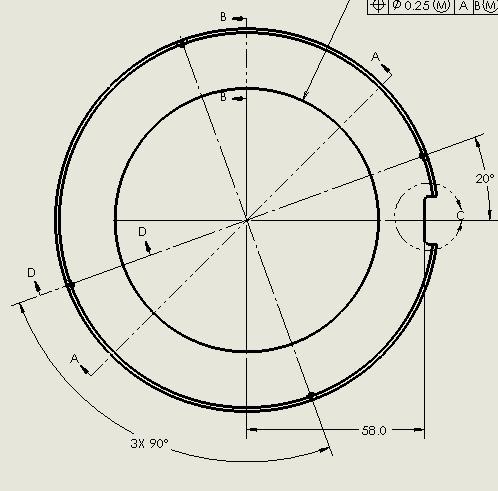-
1
- #1
Navigation
Install the app
How to install the app on iOS
Follow along with the video below to see how to install our site as a web app on your home screen.
Note: This feature may not be available in some browsers.
More options
Style variation
-
Congratulations TugboatEng on being selected by the Eng-Tips community for having the most helpful posts in the forums last week. Way to Go!
You are using an out of date browser. It may not display this or other websites correctly.
You should upgrade or use an alternative browser.
You should upgrade or use an alternative browser.
What is the correct callout for number of instances 2
- Thread starter jbird68
- Start date
- Status
- Not open for further replies.
Maybe neither is needed. Since 90° is implied then it is not to be shown.
maybe this applies (2209, ASME Y14.5-2009)
2.1.1.3 Implied 90° Angle. By convention, where center
lines and surfaces of features are depicted on 2D orthographic
engineering drawings intersecting at right angles, a
90° angle is not specified. Implied 90° angles are understood
to apply. The tolerance on these implied 90° angles is the
same as for all other angular features shown on the field of
the drawing governed by general angular tolerance notes
or general tolerance block values.
maybe this applies (
2.1.1.3 Implied 90° Angle. By convention, where center
lines and surfaces of features are depicted on 2D orthographic
engineering drawings intersecting at right angles, a
90° angle is not specified. Implied 90° angles are understood
to apply. The tolerance on these implied 90° angles is the
same as for all other angular features shown on the field of
the drawing governed by general angular tolerance notes
or general tolerance block values.
Burunduk
Mechanical
- May 2, 2019
- 2,580
greenimi has a good point, but for these specific dimensions I prefer to think (hope) that there is a note somewhere that states UNTOLERANCED DIMENSIONS ARE BASIC and then "2.1.1.4 Implied 90° or 0° Basic Angle" applies. A note such as EQUALLY SPACED could clarify the intent without having the indecision between 3X and 4X.
What are these dots anyway?
What are these dots anyway?
- Thread starter
- #6
ewh said:AS SHOWN 3X is correct; 4X would present a tolerance issue.
The 4X specification explicitly states that the spacing is equal. If the spacing is not 90[°] (3X[ ]85[°]), it should be 3X.
--
JHG
CheckerHater
Mechanical
According to the standard, the numeral represents "number of places", that's it: 4 holes = 4 times the dimension:
"For every expert there is an equal and opposite expert"
Arthur C. Clarke Profiles of the future
"For every expert there is an equal and opposite expert"
Arthur C. Clarke Profiles of the future
I think ewh is on to something. By saying 3X, then any associated tolerance (perhaps +/- 1 degree) can accumulate so that the 4th angle feels a stack-up, resulting in 87 degrees. That might be why they only said 3X.
However, as pointed out above, that's still a poor design because we don't know which 3 they intended.
However, as pointed out above, that's still a poor design because we don't know which 3 they intended.
CH - sure. However, pick one hole to start with. Move one space. Then another. Until one has counted as many spaces as noted. The last space will bring the location back to the first hole, making the last count/space redundant. Double dimensioned. No great problem if they are basic, but a huge problem if the tolerance on the origin hole is driven by two different dimensions.
It does fit in with my previous observation that there is an expectation that fabrication variations are usually so much smaller than functional requirements - in this case dividing heads for positioning such holes - that the problem goes unnoticed. Perhaps they felt that cranking the dividing head as many times as there are holes to reset it for the next part was the appropriate count for the drawing?
It does fit in with my previous observation that there is an expectation that fabrication variations are usually so much smaller than functional requirements - in this case dividing heads for positioning such holes - that the problem goes unnoticed. Perhaps they felt that cranking the dividing head as many times as there are holes to reset it for the next part was the appropriate count for the drawing?
For a long time, I followed a (my) strict interpretation of Y14.5 in that 4X should be considered double dimensioned. I have since come around realizing that such a dimension guarantees that no single angle among the 4 would be allowed to violate the tolerance while max/min tolerance accumulation would be impossible if the tolerance per instance were met. [edit]A sneaky way to position them angularly without a FCF or BSC dimension involved. Suggest proper GD&T dimensioning over this. If that is not an option, I would only use the clocking angle and the presence of the crosshair to define the location. [/edit]
3X on the other hand is asking for accumulation.
![[hourglass] [hourglass] [hourglass]](/data/assets/smilies/hourglass.gif)
"Know the rules well, so you can break them effectively."
-Dalai Lama XIV
3X on the other hand is asking for accumulation.
![[hourglass] [hourglass] [hourglass]](/data/assets/smilies/hourglass.gif)
"Know the rules well, so you can break them effectively."
-Dalai Lama XIV
-
1
- #13
- Status
- Not open for further replies.
Similar threads
- Locked
- Question
- Replies
- 7
- Views
- 5K
- Question
- Replies
- 3
- Views
- 2K
- Replies
- 75
- Views
- 14K
- Locked
- Question
- Replies
- 8
- Views
- 4K
- Question
- Replies
- 23
- Views
- 6K

